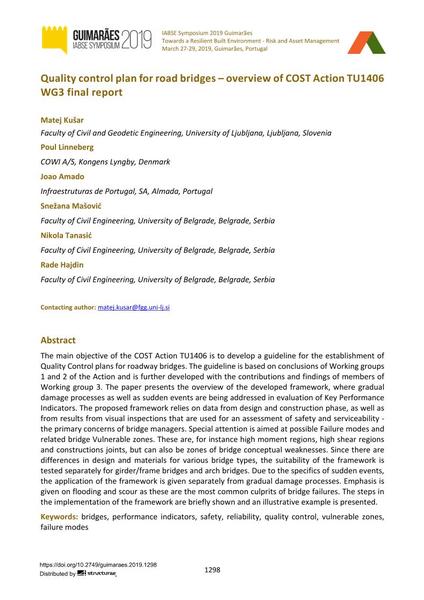Quality control plan for road bridges – overview of COST Action TU1406 WG3 final report

|
|
|||||||||||
Détails bibliographiques
| Auteur(s): |
Matej Kušar
(Faculty of Civil and Geodetic Engineering, University of Ljubljana, Ljubljana, Slovenia)
Poul Linneberg (COWI A/S, Kongens Lyngby, Denmark) Joao Amado (Infraestruturas de Portugal, SA, Almada, Portugal) Snežana Mašović (Faculty of Civil Engineering, University of Belgrade, Belgrade, Serbia) Nikola Tanasić (Faculty of Civil Engineering, University of Belgrade, Belgrade, Serbia) Rade Hajdin |
||||
|---|---|---|---|---|---|
| Médium: | papier de conférence | ||||
| Langue(s): | anglais | ||||
| Conférence: | IABSE Symposium: Towards a Resilient Built Environment Risk and Asset Management, Guimarães, Portugal, 27-29 March 2019 | ||||
| Publié dans: | IABSE Symposium Guimarães 2019 | ||||
|
|||||
| Page(s): | 1298-1305 | ||||
| Nombre total de pages (du PDF): | 8 | ||||
| DOI: | 10.2749/guimaraes.2019.1298 | ||||
| Abstrait: |
The main objective of the COST Action TU1406 is to develop a guideline for the establishment of Quality Control plans for roadway bridges. The guideline is based on conclusions of Working groups 1 and 2 of the Action and is further developed with the contributions and findings of members of Working group 3. The paper presents the overview of the developed framework, where gradual damage processes as well as sudden events are being addressed in evaluation of Key Performance Indicators. The proposed framework relies on data from design and construction phase, as well as from results from visual inspections that are used for an assessment of safety and serviceability - the primary concerns of bridge managers. Special attention is aimed at possible Failure modes and related bridge Vulnerable zones. These are, for instance high moment regions, high shear regions and constructions joints, but can also be zones of bridge conceptual weaknesses. Since there are differences in design and materials for various bridge types, the suitability of the framework is tested separately for girder/frame bridges and arch bridges. Due to the specifics of sudden events, the application of the framework is given separately from gradual damage processes. Emphasis is given on flooding and scour as these are the most common culprits of bridge failures. The steps in the implementation of the framework are briefly shown and an illustrative example is presented. |
||||
| Mots-clé: |
ponts
|
||||
